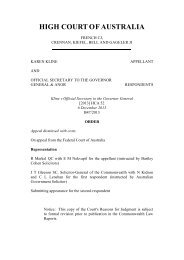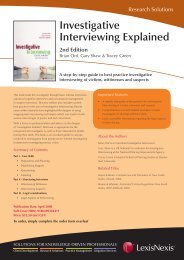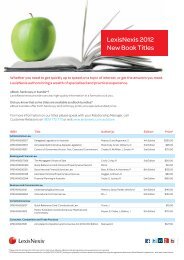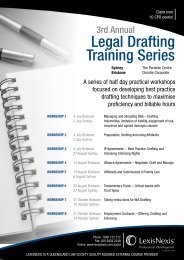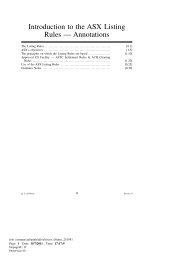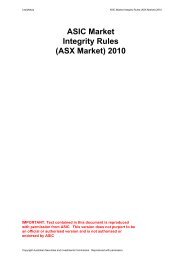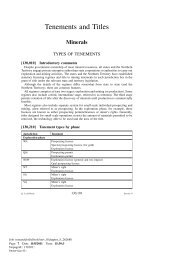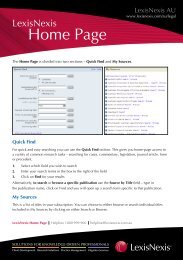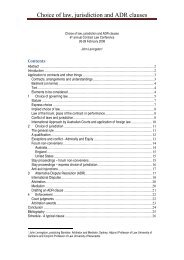Copyright LexisNexis. Sample only, not for classroom use or ...
Copyright LexisNexis. Sample only, not for classroom use or ...
Copyright LexisNexis. Sample only, not for classroom use or ...
Create successful ePaper yourself
Turn your PDF publications into a flip-book with our unique Google optimized e-Paper software.
275<br />
CHAPTER 12: EQUITABLE ESTOPPEL<br />
entirety. It will suffice if so much of the representation as is necessary to found the propounded<br />
estoppel satisfies the requirement.<br />
12.32 In relation to the statement by Mason and Deane JJ that the representation does <strong>not</strong> have to<br />
be totally clear and unambiguous <strong>or</strong> free of any uncertainty, in Australian Crime Commission v Gray<br />
at [205], Ipp JA proffered the following example:<br />
Say, <strong>f<strong>or</strong></strong> example, a non-contractual representation was made whereby the represent<strong>or</strong> <strong>or</strong>ally<br />
promised to deliver a large quantity of produce specified by a nominated tonnage. Assume that<br />
the promise did <strong>not</strong> specify imperial tons <strong>or</strong> metric tonnes in circumstances where it was <strong>not</strong><br />
reasonably possible to infer whether tons <strong>or</strong> tonnes were promised. Assume that the [relying<br />
party] relied on the promise and altered its position to its detriment. Assume further that the<br />
represent<strong>or</strong> made no delivery whatever and repudiated its promise. If, in these circumstances,<br />
the [relying party] sued on the grounds of a promiss<strong>or</strong>y estoppel, I suggest that it would be selfevident<br />
that the represent<strong>or</strong> would be liable to pay equitable compensation even though it was <strong>not</strong><br />
possible to determine whether the quantity promised was in metric <strong>or</strong> imperial quantities. The<br />
unconscionability of the situation would <strong>not</strong> be negated by the ambiguity. Equity would intervene<br />
by fashioning relief based on the concept of ‘minimum detriment’.<br />
However, in Westpac Banking C<strong>or</strong>p<strong>or</strong>ation v the Bell Group Ltd (in liq) (No 3) [2012] WASCA 157 at<br />
[1748]–[1751], Drummond AJA expressed the view that ambiguity <strong>or</strong> lack of clarity will be fatal to<br />
any promiss<strong>or</strong>y estoppel case. However, this was <strong>not</strong> necessarily so in proprietary estoppel cases where<br />
‘vague and imprecise conduct is often enough to give rise to an equitable proprietary estoppel’. His<br />
Honour, at [1753], observed that this was so beca<strong>use</strong>, unlike promiss<strong>or</strong>y estoppel cases, proprietary<br />
estoppel cases ‘do <strong>not</strong> depend on proof of clear representations <strong>or</strong> promises but on conduct with<br />
respect to property of the parties said to be estopped that is often diff<strong>use</strong> and ambiguous, but which<br />
is sufficient, in the circumstances of the particular case, to attract the intervention of equity’.<br />
12.33 Furtherm<strong>or</strong>e, whether the relevant representation is sufficiently clear and unambiguous is,<br />
as L<strong>or</strong>d Walker of Gestingth<strong>or</strong>pe observed in Th<strong>or</strong>ner v Maj<strong>or</strong> [2009] 3 All ER 945 at 964, ‘hugely<br />
dependent on context’. Thus, in Accurate Financial Consultants Pty Ltd v Koko Black Pty Ltd [2008]<br />
VSCA 86 at [178], Dodds-Streeton JA said:<br />
A representation which is insufficiently certain <strong>or</strong> complete to create a contract may found<br />
proprietary estoppel. Where necessary to inhibit unconscionability, equity will construe a<br />
representation robustly in context, to determine its meaning as reasonably understood by the<br />
addressee. In my opinion, the standard of certainty, clarity and completeness required of the<br />
representation can<strong>not</strong> sensibly be determined in isolation from other elements of proprietary<br />
estoppel in the circumstances of each particular case. M<strong>or</strong>eover, ambiguity <strong>or</strong> indeterminacy<br />
generated by the represent<strong>or</strong> in the context of unconscionable conduct should <strong>not</strong> confer<br />
immunity from equity’s ‘long arm’.<br />
12.34 In light of the above, it is understandable that in Yeoman’s Row Management Ltd v Cobbe<br />
at 726, L<strong>or</strong>d Scott of Foscote said that, in the context of an arm’s length negotiation between<br />
experienced businessmen, ‘[a]n expectation dependent upon the conclusion of a successful<br />
negotiation is <strong>not</strong> an expectation of an interest having [sufficient] certainty’ to ground a claim<br />
in equitable estoppel. However, in Th<strong>or</strong>ner v Maj<strong>or</strong>, in the context of a family relationship, an<br />
<strong>Copyright</strong> <strong>LexisNexis</strong>. <strong>Sample</strong> <strong>only</strong>, <strong>not</strong> <strong>f<strong>or</strong></strong> <strong>classroom</strong> <strong>use</strong> <strong>or</strong> distribution.<br />
Spi-Radan & Stewart - Principles of Australian Equity and Trusts 2nd ed. Ch.12.indd 275 10/10/2012 05:22:31<br />
200595



